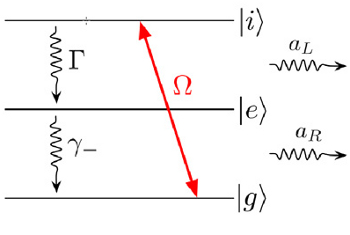Imagine that data held in a computer suffers random changes in the middle of a calculation. Not helpful, right? Wrong - at least in a quantum scenario. Researchers have discovered that a process known as spontaneous emission that was previously seen as creating unhelpful noise in quantum data can be harnessed not only to protect the data, but even to compute.
The finding offers a new strategy for building quantum-information processing devices. "Exploring spontaneous emission to protect entanglement and quantum compute may help us build quantum devices in the near future," says Marcelo Franca Santos, who initiated the research during a sabbatical at CQT from January 2010 to March 2011. He has since returned to his permanent position at the Universidade Federal de Minas Gerais (UFMG) in Belo Horizonte, Brazil.
Marcelo and his collaborators published on 25 April in Physical Review Letters the third in a series of papers on harnessing spontaneous emission. The earlier papers appeared in 2011 in New Journal of Physics and in Europhysics Letters. Pictured above is Marcelo (right) with collaborator Andre Carvalho of the Australian National University.
 A three-level qubit scheme converts spontaneous emission from a problem to a tool for computing. Figure from New J. Phys. 13, 013013 (2011).
A three-level qubit scheme converts spontaneous emission from a problem to a tool for computing. Figure from New J. Phys. 13, 013013 (2011).
Spontaneous emission is when a system suddenly spits out a photon, transferring to a lower energy state. The process has long worried researchers exploring the idea of quantum bits (qubits) stored in two-level systems because it is uncontrolled noise that affects the stored data.
Consider a typical qubit scheme: a higher-energy state encodes a '1' and a lower-energy state a '0'. This can be implemented in an atom, for example. Spontaneous emission moves the system from the higher to the lower energy state. In other words, it randomly flips the bit from 1 to 0, which, repeated over many bits, turns data into junk.
Technically, spontaneous emission is said to contribute to 'decoherence', which includes the loss of quantum properties of a qubit such as superposition (the ability to be 1 and 0 at once) and entanglement (when two qubits are linked in a joint state).
In the first of the three papers, Marcelo and Andre, whom Marcelo hosted at CQT in September 2010, showed that spontaneous emission noise can be rehabilitated from a cause of decoherence to something that helps control it. This paper was included in the publisher's IOP Select - a collection of papers chosen by editors "for their novelty, significance and potential impact on future research".
"The sabbatical in CQT was the most productive year I have had in ages, and visiting my friends and collaborators in the center has become one of the greatest pleasures of my scientific and personal life," says Marcelo.
Marcelo and Andre came up with the idea of replacing the typical two-level qubit with a three-level system (pictured left). In this arrangement, there are two possibilities for spontaneous emission: one puts the system into the 1 state, the other into the 0 state. An additional process, known as inelastic scattering, counterbalances the spontaneous emission: it bounces the atoms from the lowest energy state back up to the top state.
The photons from spontaneous emission become a tool for protecting the qubit when the two processes produce photons of the same frequency and line-width. In a two-level system, detection of a spontaneously emitted photon 'collapses' the state of the qubit - the measurement would reveal the system to be in the lower-energy 0 state, destroying any entanglement or superposition. In the three-level case, detecting the photon doesn't reveal whether the system is in the 1 or 0 state because photons from both processes look the same. That means the decoherence doesn't happen; indeed, the detection of the photon can help preserve the quantum state.
Marcelo and Andre's next paper examined physical systems that might implement the idea. This article in European Physics Letters was highlighted in the Sep/Oct 2011 volume of Europhysics News and featured in the journal's "Best of 2011" list. The newest paper, emerging from discussion at a conference with additional authors Marcelo Terra Cunha from UFMG in Brazil and Rafael Chaves from ICFO-Institute of Photonic Sciences in Spain, gives impetus to efforts to realise such schemes.
The researchers show how clever detection of the spontaneous emission photons can control the qubits to efficiently implement the single-qubit operations and entangling two-qubit gates that underpin quantum computation (see picture). For example, when the photons emitted by the two spontaneous emission processes have different polarisations (but still the same frequencies), careful choice of how to measure the polarisation gives control over how much 1 is mixed with how much 0 in the qubit. Two qubits can also be entangled in any way.
Experimental success for the approach depends on how many of the emitted photons are caught. If all can be detected, the system works perfectly, but errors creep in with every lost photon. State-of-the art single photon detectors have reached efficiencies around 99%, and experiments are planned.